There are many things to think about when organizing a trip to the Maldives, Maldives currency is one of them . Every little aspect, from picking the ideal overwater bungalow to picking the ideal time to visit, is essential to having a memorable trip. Understanding the Maldives’ money is one such issue that frequently goes unnoticed yet is of utmost significance. We, as seasoned professionals in the area, strive to give you all the knowledge you require about Maldives currency in this in-depth guide to ensure that your trip is smooth and pleasurable.

Understanding the Maldives currency Rufiyaa (MVR)
The Maldives currency Rufiyaa, represented by the currency code MVR, is the Maldives’ official unit of account. The Maldives Monetary Authority (MMA) is responsible for issuing and overseeing the distinctive Maldivian Rufiyaa currency. Let’s delve deeper into the various facets of Maldivian currency to make sure you fully understand it:

Banknotes and Coins
Banknotes
Maldives currency Rufiyaa banknotes come in various denominations, including MVR 5, MVR 10, MVR 20, MVR 50, MVR 100, MVR 500, and MVR 1000. Each denomination is uniquely designed, featuring vibrant colors and intricate patterns that reflect the rich culture and natural beauty of the Maldives.

Coins
In addition to banknotes, coins are also widely used in the Maldives. The most commonly circulated coins include MVR 1, MVR 2, MVR 5, and MVR 10. These coins are convenient for small transactions and are often used for purchasing souvenirs or snacks in local markets.
- 1 laari
- 2 laari
- 5 laari
- 10 laari
- 25 laari
- 50 laari
- 1 Rufiyaa

Also Read: Tim Cook Net Worth 2023: Salary, Rupee Net Worth (INR), Income
Exchange Rates
It’s imperative to have a fundamental understanding of exchange rates before starting your trip to the Maldives. The value of the Maldivian Rufiyaa changes, therefore it’s wise to verify the most recent rates from reputable sources or your neighborhood bank. International visitors can easily travel to the Maldives because many hotels and establishments there accept significant foreign currencies like the US Dollar and Euro.

Currency Exchange
You may exchange money when you arrive in the Maldives at the airport and in the main tourist regions. To pay for emergency needs, it is advised to exchange a modest sum of your local currency for Maldives currency Rufiyaa at the airport. You can find competitive rates at authorized exchange offices or local banks for larger currency exchange operations.

Credit Cards and ATMs
In the Maldives, credit cards are routinely accepted, particularly in upscale resorts and eateries. For modest transactions, though, it’s a good idea to have some cash on hand because not all merchants accept cards. The capital city of Male and certain tourist locations have plenty of ATMs. Plan your trip taking into account the possibility of limited ATM availability on distant islands.

Tipping in Maldives
In the Maldives, gratuities are rarely expected because a 10% service charge is frequently included to hotel and restaurant tabs. To give a little gratuity for great service, though, is customary. Depending on your preference, you can pay in either Maldivian Rufiyaa or another currency.

Conclusion
In conclusion, for a seamless and trouble-free trip in this tropical paradise, understanding the Maldives currency Rufiyaa, the local money, is crucial. Understanding the local currency will improve your trip whether you’re partaking in water sports, discovering vivid coral reefs, or simply unwinding on pristine beaches. A mix of cash and credit cards should be carried, currency rates should be checked, and you should enjoy the Maldives’ beauty while being prepared financially.
Also Read: Prize money For The ICC Men’s Cricket World Cup 2023 Has Been Declared
image source: google




































